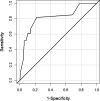Development and Validation of a Tool for the Prediction of Vancomycin-Resistant Enterococci Colonization Persistence-the PREVENT Score
- PMID: 34523992
- PMCID: PMC8557884
- DOI: 10.1128/Spectrum.00356-21
Development and Validation of a Tool for the Prediction of Vancomycin-Resistant Enterococci Colonization Persistence-the PREVENT Score
Abstract
Vancomycin-resistant enterococci (VRE) are nosocomial pathogens with increasing prevalence worldwide. Extensive hygiene measures have been established to prevent infection transmission in hospitals. Here, we developed a predictive score system (the predictive vancomycin-resistant enterococci [PREVENT] score) to identify the clearance or persistence in patients with a history of VRE carrier status at readmission. Over a cumulative 3-year period, patients with a positive VRE carrier status were included. The study population was recruited in two successive time periods and separated into training data for predictive score development and validation data for evaluation of the predictive power. The risk factors for persistent VRE colonization were analyzed in a univariable analysis before development of a logistic regression model based on the potential risk factors. The score points were determined proportionally to the beta coefficients of the logistic regression model. The data from 448 (79%) patients were used as the training data, and those from 119 (21%) as the validation data. Multivariable analysis revealed the following variables as independent risk factors: age of ≥60 years, hemato-oncological disease, cumulative antibiotic treatment for >4 weeks, and a VRE infection. The resulting logistic regression model exhibited an acceptable area under the curve (AUC) of 0.81 (95% confidence interval [CI], 0.72 to 0.91). The predictive score system had a sensitivity of 82% (95% CI, 65 to 93%) and a specificity of 77% (95% CI, 66 to 85%). The developed predictive score system is a useful tool to assess the VRE carrier status of patients with a history of VRE colonization. On the basis of this risk assessment, more focused and cost-effective infection control measures can be implemented. IMPORTANCE Given the increasing relevance of VRE as nosocomial pathogens worldwide, infection prevention and control measures, including patient isolation and contact precautions, are indispensable to avoid their spread in the hospital setting. In this study, we developed and validated the PREVENT score, a tool for rapid risk assessment of VRE persistence in patients with a history of previous VRE colonization. The score is designed to be easily performed, employing clinical information available in a regular admission setting and immediately providing information to inform the decision of whether to adopt patient isolation and contact precautions during the hospital stay. After validation, the score was shown to accurately identify patients with persistent VRE colonization upon admission, representing a suitable option as (i) a complementary method yielding preliminary results significantly more quickly than culture-based VRE detection techniques and (ii) an alternative strategy for VRE detection in settings in which microbiological VRE screening is not routinely performed due to limited resources.
Keywords: contact precaution; prediction score; screening; vancomycin-resistant enterococci.
Figures



References
-
- European Centre for Disease Prevention and Control. 2021. Surveillance atlas of infectious diseases. https://atlas.ecdc.europa.eu/public/index.aspx.
-
- Pfaller MA, Cormican M, Flamm RK, Mendes RE, Jones RN. 2019. Temporal and geographic variation in antimicrobial susceptibility and resistance patterns of enterococci: results from the SENTRY Antimicrobial Surveillance Program, 1997–2016. Open Forum Infect Dis 6:S54–S62. doi:10.1093/ofid/ofy344. - DOI - PMC - PubMed
-
- Bonten MJM, Slaughter S, Ambergen AW, Hayden MK, van Voorhis J, Nathan C, Weinstein RA. 1998. The role of “colonization pressure” in the spread of vancomycin-resistant enterococci: an important infection control variable. Arch Intern Med 158:1127–1132. doi:10.1001/archinte.158.10.1127. - DOI - PubMed
-
- Ford CD, Lopansri BK, Gazdik MA, Webb B, Snow GL, Hoda D, Adams B, Petersen FB. 2016. Room contamination, patient colonization pressure, and the risk of vancomycin-resistant Enterococcus colonization on a unit dedicated to the treatment of hematologic malignancies and hematopoietic stem cell transplantation. Am J Infect Control 44:1110–1115. doi:10.1016/j.ajic.2016.03.044. - DOI - PubMed
Publication types
MeSH terms
LinkOut - more resources
Full Text Sources
Medical

